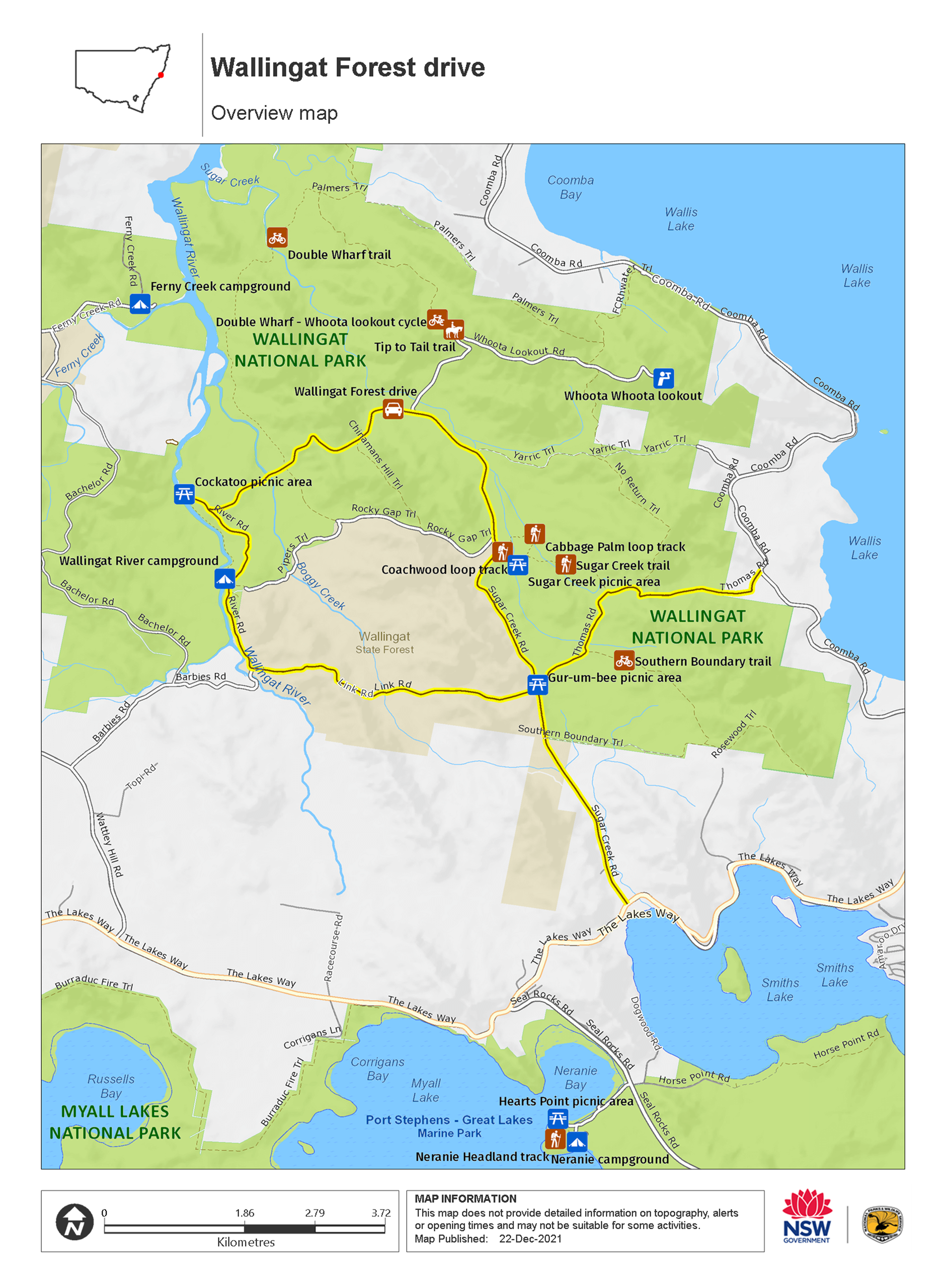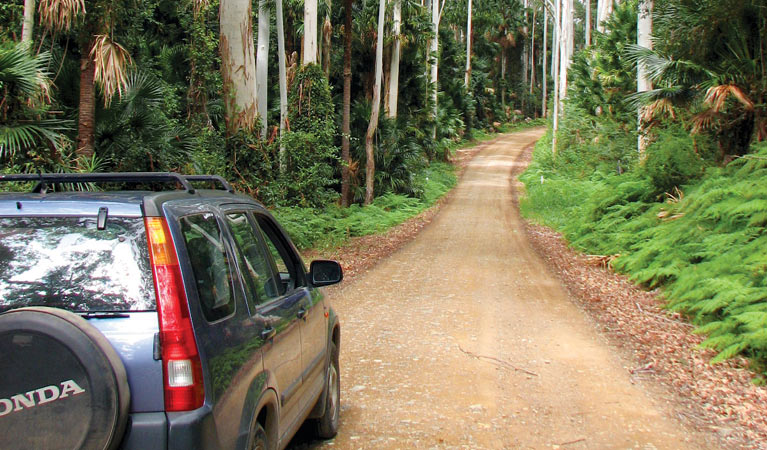Overview
The 25km loop of Wallingat Forest drive, near Forster, is on unsealed roads that meander through forests, and excellent for cars, 4WDs, bicycles, walking and horse riding.
- Where
- Wallingat National Park in North Coast
- Distance
- 25km loop
- Time suggested
- 7hrs
- Grade
- Easy
- What to
bring - Drinking water
- Please note
- This is a narrow road, two-way, and shared by cars, bikes, hikers and horse-riders. Please take caution on this route.
- The road network contains a number of timber bridges, some of which have limited load carrying capacity. The main bridge over Boggy Creek on Sugar Creek Road has a load limit of 3 tonnes.
Prepare to see all Wallingat National Park has to offer in one easy drive. The 25km loop that is Wallingat Forest drive takes you through the thick forest, the snow-white trunks of gum trees towering over you, and underneath the vast leaves of the cabbage palm shading the road. The route takes in all the major sites of the park, including Wallingat River picnic area, where you can stop for a swim. Be sure to bring an esky full of sandwiches and barbecue essentials so you can relax at Sugar Creek picnic area.
You’ll see birds swooping low throughout the drive, wallabies bounding across your path, and maybe even a goanna basking in the sun – so be sure to drive with care. This is an unsealed road, so plan your trip well – wet weather makes it unsuitable for 2WD vehicles. If you’re feeling energetic, you can go mountain biking or horse riding along the circuit. Any way you enjoy this route, take your time, relax and enjoy.
Map

Map legend

Local alerts
For the latest updates on fires, closures and other alerts in this area, see https://www.nationalparks.nsw.gov.au/things-to-do/driving-routes/wallingat-forest-drive/local-alerts
General enquiries
- National Parks Contact Centre
- 7am to 7pm daily
- 1300 072 757 (13000 PARKS) for the cost of a local call within Australia excluding mobiles
- parks.info@environment.nsw.gov.au
Park info
- in Wallingat National Park in the North Coast region
Wallingat National Park is always open but may have to close at times due to extreme weather or fire danger.
Visitor info
All the practical information you need to know about Wallingat Forest drive.
Getting there and parking
Get driving directions
On entering Wallingat National Park, start at either Sugar Creek Road or Thomas Road.
Parking
Parking is available at the picnic areas and campgrounds on the drive. Parking on campgrounds is for campers only.
Best times to visit
There are lots of great things waiting for you in Wallingat National Park. Here are some of the highlights.
Autumn
With temperatures slightly cooler, explore the network of gravel roads by foot or on a mountain bike.
Spring
With the wildflowers - including the purple blooms of the velvet mint-bush - coming out, this is a great time for birdwatching.
Summer
The weather is warm and sunny, so now's the time to pitch a tent and stay for a few days. Make the most of the boat ramp at Cockatoo picnic area Head to Sugar Creek picnic area and, after lunch, take a walk through the cool forest. .
Winter
Visitor numbers are down, so take the car along the park's unsealed roads and discover the forest, rivers and lake.
Weather, temperature and rainfall
Summer temperature
Average
20°C and 29°C
Highest recorded
45.2°C
Winter temperature
Average
7°C and 21°C
Lowest recorded
-5°C
Rainfall
Wettest month
March
Driest month
Sept
The area’s highest recorded rainfall in one day
280.2mm
Facilities
- You'll need to bring your own drinking water
- Firewood may not be collected from the park
Maps and downloads
Permitted
Fishing
A current NSW recreational fishing licence is required when fishing in all waters.
Prohibited
Pets
Pets and domestic animals (other than certified assistance animals) are not permitted. Find out which regional parks allow dog walking and see the pets in parks policy for more information.
If you're travelling through a national park or reserve on a public road you can have pets inside your vehicle. However, you must keep them inside your vehicle while driving through national parks or reserves. You must also comply with any conditions in the park’s plan of management, and you cannot stop to visit the park or use park facilities (unless for safety reasons, or to use publicly accessible toilets).
Smoking
NSW national parks are no smoking areas.
Learn more
Wallingat Forest drive is in Wallingat National Park. Here are just some of the reasons why this park is special:
Ancient footprints

The 6,557ha of Wallingat National Park is part of the identity and spirituality, as well as a resource, for people of the Worimi nation. The Worimi People lived a traditional hunter-gatherer lifestyle and used the leaves of the cabbage palm for weaving baskets and its fibrous bark for making fishing line. They used many of the area's natural resources, including the freshwater lakes, stone outcrops, and the ocean. A central campsite was known to exist in the area now known as Coomba Park, although there are few other Aboriginal sites recorded within the park include the Bungwahl area.
Fun times

Whether you're after a relaxing time or something more adventurous, Wallingat is just the spot. Take to the gravel roads either on foot, in a car or on a bike – to explore the forests. You can swim, fish and paddle on Wallingat River. Pitch a tent in the campground and get away from it all for a few days in this naturally beautiful setting. Surrounding some of the picnic areas and campsites, you’ll find magnificent stands of trees. In the southeast corner of Wallingat, there are tall, straight flooded gums, as well as stands of cabbage palms. Find both during a walk from Sugar Creek picnic area. Some rare plants such as the liana woody climber, a climbing species that bears white flowers from August to May, can also be found here.
- Double Wharf trail Experience the scenic waterways and mountainous forests of Wallingat National Park along Double Wharf trail – perfect for walking or mountain bike riding.
- Wallingat Forest drive The 25km loop of Wallingat Forest drive, near Forster, is on unsealed roads that meander through forests, and excellent for cars, 4WDs, bicycles, walking and horse riding.
- Whoota Whoota lookout From Whoota Whoota lookout, easily accessible by car, you can see for miles. Take in scenic views of Wallingat’s eucalypt forests, Wallis Lake and 100km of coastline.
Life among the trees

More than 200 species of birds make Wallingat National Park a home. Walking through forest as well as stands of straight flooded gums, and cabbage palms, you'll hear birds singing. Noisy friarbirds, for instance, have a distinctive 'ya-kob' call, while a 'woop, woop, woop' sound signals the presence of the wonga pigeon. You might see blue wrens flitting through the trees, as well as king parrots and glossy black cockatoos. Wallingat is also a popular spot for the satin bowerbird – the males are black and shiny, the females are a plainer brown. They both, however, have startling lilac eyes.
- Double Wharf trail Experience the scenic waterways and mountainous forests of Wallingat National Park along Double Wharf trail – perfect for walking or mountain bike riding.
- Sugar Creek picnic area Sugar Creek picnic area is a family-friendly relaxation spot with easy walking trails through forested landscape, a leisurely drive from Forster and Pacific Palms.

